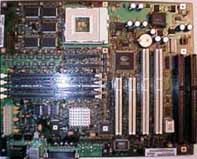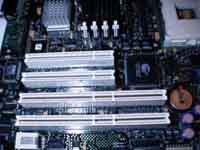Multiwave Direct Digital Alpha
by Anand Lal Shimpi on February 19, 1998 6:17 PM EST- Posted in
- Systems
Looking at the Multiwave Alpha System from a distance, one would assume that it is no different than a Clone Pentium II system, the 1.44 Floppy, 24X CD-ROM drive, and AOpen Mid Tower case provide for an excellent disguise for the Digital Alpha powerhouse CPU found under the hood. Removing the case of the MWave system wasn't a problem at all, 4 standard sized Phillips head screws on the back of the case held the external housing in place, by removing those four the outer casing slid off from the back, a piece of cake. |
 |
The interior of the Alpha system was much like any normal ATX system, unfortunately the AT/ATX combination design of the AOpen case was a bit cramped for a Mid Tower case. The ATX form factor Digital 164SX motherboard fit snugly into the case, however it positioned the 21164PC's massive heatsink in the way of one of the 2 internal hidden Hard Drive bays, rendering that bay unusable. The close proximity of the Western Digital 4.3GB Ultra ATA drive to the Alpha's Heatsink/Fan combo may leave you with a sense of uncertainty about the system's assembly, however in the tests conducted the system didn't exhibit any problems because of this. The path directly above the 21164PC's fan was left unobstructed for the most part, keeping the processor fairly cool.
While running the ambient case temperature didn't seem to be any different than the Pentium II - 333 system it was pit against, however the design of the motherboard placed the 21164PC's 413-pin Socket in a conventional AT motherboard position, instead of in the path of the Power Supply's fan which makes cooling this system a little larger task than you would expect from a "ATX" System. It would have been nice if Digital had conformed to the ATX 2.1 specification with the design of their 164SX motherboard, but you can't always get everything you wish for.
| The motherboard tested with the 21164PC, as mentioned above, was a Digital 164SX motherboard, the motherboard features a total of 4 PCI slots and 2 ISA (none shared) with two of the 4 PCI slots featuring the extended connector to support 64-bit PCI cards such as high end graphics adapters (current Socket-7/Slot-1 systems use 32-bit PCI slots). Any of the four slots can be populated by 32-bit PCI cards, there is no performance increase achieved by running a 32-bit PCI card in a 64-bit slot since both slots operate at 33MHz, however a "true" 64-bit PCI card, one that has the extension on the card, can only be installed in a 64-bit PCI slot. |  |
| The 4 PCI slots are divided into a pair of standard 32-bit PCI slots, and another pair of 64-bit PCI slots that can accept both 32-bit and 64-bit PCI cards. The system came shipped with a Matrox Millennium II in one of the PCI slots, however the Millennium II isn't available as a 64-bit card, for that you must divert your attention to some more expensive solutions, particularly ones based on 3DLabs' high end chipsets. The other device occupying a PCI slot was the PCI Network Interface card, a standard 100Mbps Network card making this Alpha System ideal for use on a network. |  |
One of the two ISA slots (none of which are shared) received the attention of the Creative Labs Sound Blaster AWE64 Value Edition card which came standard with the MWave System, although the Alpha isn't much of a gaming platform it is nice to know that you don't lose any of the fringe benefits x86 PC users take for granted with the Alpha.
The 164SX, based on the Digital Semiconductor 21174 Chipset, uses 4 DIMM slots that can accept SDRAM DIMMs in sizes from 16MB to 128MB, the catch here is that the SDRAM must be installed in pairs. In Socket-7 and Slot-1 systems, to equal the 64-bit memory data bus a single 64-bit wide DIMM can be installed with no problems what-so-ever, however Alpha systems feature a much wider 128-bit data path to the memory, requiring the use of 2 64-bit DIMMs to equal the width of the data bus (2 x 64-bits = 128-bit data bus). Don't think that Multiwave chose to skimp on the RAM on their mid-level Alpha system, the requirements for SDRAM on the 164SX are very strict, comparable to the PC100 Specification by Intel. The system which was tested here used 2 x 32MB 10ns - 100MHz Viking SDRAM DIMMs, very high quality memory. For the purpose of making the tests even between the two systems compared here the Viking DIMMs were replaced by two 64MB Advanced Megatrends 10ns 100MHz SDRAM DIMMs which worked perfectly in both the Alpha and the Pentium II systems.
Surprisingly enough, the ATX form factor 164SX features an on-board Cypress CY82C693U controller chip that supports two EIDE channels, a keyboard, mouse, as well as a PCI-to-ISA bridge all in one unit...no SCSI for this system, the 21164PC is obviously a processor for those looking for outstanding performance at a degraded cost. The Western Digital Caviar was installed on the Primary IDE channel found on the 164SX motherboard, with the AOpen 24X CD-ROM drive configured as a master on the Secondary Channel.
The floppy disk controller is a standard National Semiconductor Super I/O, similar controllers can be found on nearly any standard PC motherboard. The once foreign Digital Alpha world is now beginning to look a lot like the standard x86 realm...that was Digital's plan from day one, and it is quite apparent in the 21164PC.










0 Comments
View All Comments